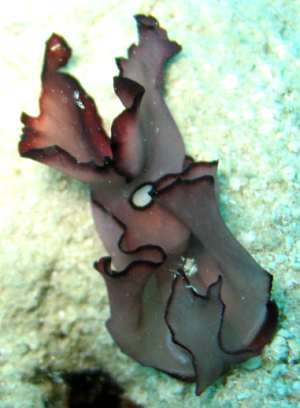
Aglajid sp. 6
Order: CEPHALASPIDEA
Superfamily: PHILINOIDEA
Family: Aglajidae
PHOTO
House Reef, Tekek Village, Tioman, Malaysia. on a slightly sloping silt/sand bottom between 15 to 20 metres. Approx 5-6 cm long. Photos: Michelle Tay & Jeffree Shahrizal
Although it looks something like a Sea Hare, the presence of a distinct headshield suggests it is some type of cephalaspidean bubble shell, perhaps in the family Aglajidae or Phlinidae. The parapodial flaps are very large, as are the 'tails' off the posterior end of the posterior or visceral hump. I presume there is an internal shell over the visceral hump, and there is a large hole [foramen] into the shell cavity, which is unusual in aglajids. A small pore has been reported in some species of Philine, and a small pore or a larger foramen is present in species of Sea Hare genus Aplysia. One other animal that apparently has such a foramen is Noalda exigua but it was described from a shell alone and I don't know if the one drawing of the live animal available is correctly identified or not [see message #6151 ]. Nothing is known of the anatomy of Noalda, although it is has been suggested that it is an aglajid.
Note added April 2010: see message #23454 for further discussion on possible relationship to Noalda, and N. exigua Fact Sheet for photos of living animal.
Rudman, W.B., 2005 (June 6) Aglajid sp. 6 [In] Sea Slug Forum. Australian Museum, Sydney. Available from http://www.seaslugforum.net/find/aglajidsp6
Related messages
Small Noalda? species
April 9, 2010
From: Atsushi Ono
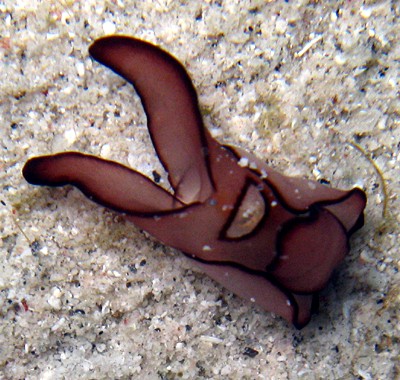
Dear Bill,
This species with a very lovely face was found last year though it was a little ugly. I couldn't find single individual this year. This species looks very like the species called Noalda sp. 3 in Indo-Pacific Nudibranchs and Sea slugs [Gosliner, Behrens & Valdes, 2008]. In this individual from the Keramas, the flagellum seem to be thin and the body length is small, but I am sure it is the same species.
Locality: Kerama Is., 25 m, Japan, East china sea, 24 Mar. 2010, sandy with mud. Length: 6 mm. Photographer: Atsushi Ono.
Atsushi Ono
ononini@cosmos.ne.jp
Ono, A., 2010 (Apr 9) Small Noalda? species. [Message in] Sea Slug Forum. Australian Museum, Sydney. Available from http://www.seaslugforum.net/find/23454Dear Atsushi,
Your mention of Indo-Pacific Nudibranchs and Sea slugs makes me feel a bit guilty because I have yet to add a review of this wonderful book on the Forum. Unfortunately with the ongoing problems I have been having with editing on the Forum, adding material to the books section has been very difficult.
Your animal is indeed what they are calling Noalda sp.3. I have had it on the Forum as Aglajiid sp. 6 and suggested a likeness to Noalda exigua. Since then I have obtained photos of the living animal of N. exigua and records of two other possible species of Noalda [Noalda sp. 1, Noalda sp. 2 ]. Unfortunately we know nothing about the anatomy of any of these species so what really links them is the 'foramen' or hole in the mantle through which part of the shell is visible.
I'll add a comment to the Aglajid sp. 6 Fact Sheet noting that it could be a species of Noalda.
Best wishes,
Bill Rudman
Aglajid sp. 6 - mating and egg case
March 19, 2008
From: Kwang Kai Leong
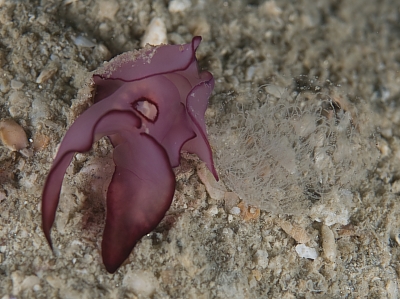
Hi Bill,
We found about 40 - 50 of this aglajid on the sea floor moving in a south by south east direction. A lot of them were carrying an egg case. A few pairs was mating. On that day there was a new moon at 7 am.
Locality: Tekek House reef, Tioman Island, 18.2 meters, Pahang, Malaysia, South China Sea, 10 November 2007, Sandy Bottom. Length: 1 - 3 inches. Photographer: KL Kwang.
Thanks
Regards
Kwang Kai Leong
klkwang@deloitte.com
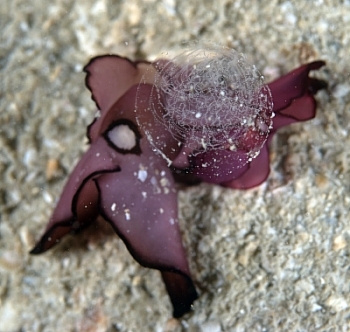
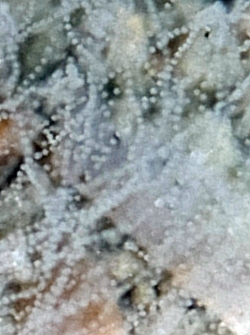
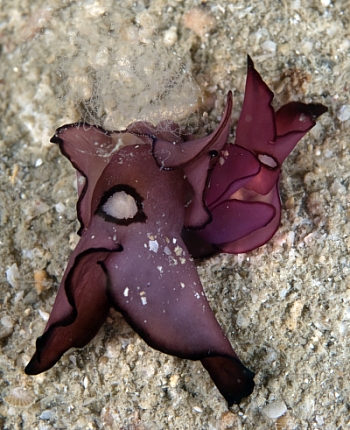
Dear KL,
Thanks for these interesting photographs and the background information. It would be very interesting to know something about the animal. It does not seem to have been described, but it is possible it has been named solely on a shell which will be a reduced flattened plate. All we can see of the shell in your photos is the white patch through the round hole ringed in black on the back of the animal. As I have said previously, I suspect it is an aglajid but we can only be sure if we have a look at its anatomy.
Best wishes,
Bill Rudman
Aglajid sp. 6 from Bali
February 14, 2008
From: Daisuke Nakayama
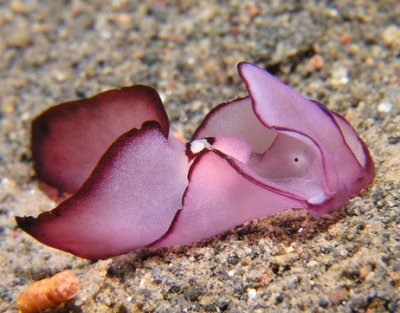
Dear Bill
Please give us the name of this species. Is it Aglajid sp. 6?
Locality: PJ, 7-12 m, Bali, Indonesia, 21 jan 2008, muddy. Length: 40 mm. Photographer: Toru TSUDA.
thank you very much.
Daisuke
daisuke@papasdive.com
Nakayama, D., 2008 (Feb 14) Aglajid sp. 6 from Bali. [Message in] Sea Slug Forum. Australian Museum, Sydney. Available from http://www.seaslugforum.net/find/21375Dear Daisuke,
Thanks very much for this photo. It is certainly the animal I have called Aglajid sp. 6. As I said about the earlier message from Malaysia, we will need to know something about its anatomy before we can even be sure which Family it belongs to. I am sure it has an internal shell. In earlier times species were often named just from the shape of their shell, so it is possible this animal has a name, but until we can see what the hidden shell in your animal looks like we won't be able to say if it already has a name or not.
Best wishes,
Bill Rudman
Re: Flatworm? from Malaysia
June 6, 2005
From: Michelle Tay & Jeffree Shahrizal
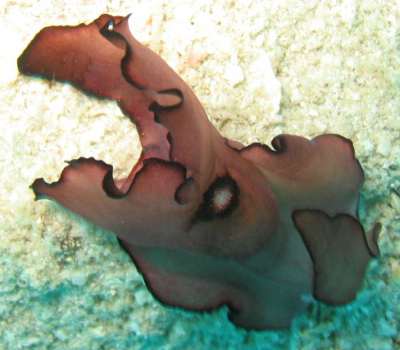
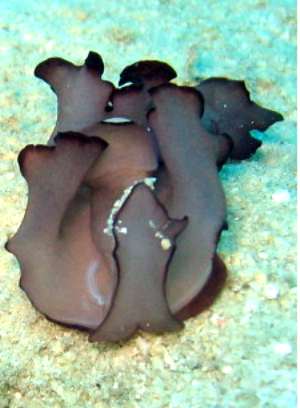
Hi Bill,
Following your request [message #13931], here are a few more photos of the animal from some different angles - all photos show just one animal - each are about 5 to 6 cm long.
Thanks for your help!
Best Regards
Michelle & Jeff
mail@eco-divers.net
Tay, M. & Shahrizal, J., 2005 (Jun 6) Re: Flatworm? from Malaysia. [Message in] Sea Slug Forum. Australian Museum, Sydney. Available from http://www.seaslugforum.net/find/13966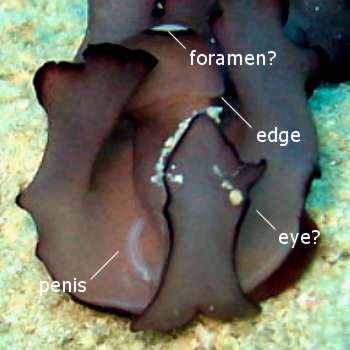
Dear Michelle & Jeffree,
I'm glad you has some other photos, as this animal is very interesting - and definitely not a flatworm. It looks quite like a Sea Hare, but the presence of a distinct headshield suggests it is a some type of cephalaspidean bubble shell, perhaps in the family Aglajidae or Phlinidae. The parapodial flaps are very large, as are the 'tails' arising from the posterior end of the posterior (visceral) hump. I presume there is an internal shell over the visceral hump, as I think its edge is visible in your photos [see labeled photo]. I also think there is a large hole [foramen ] into the shell cavity, which is unusual in aglajids. A small pore has been reported in some species of Philine, and a small pore, or a larger foramen, is present in species of the Sea Hare genus, Aplysia [see Fact Sheet on aplysiid mantle cavity]. One other animal that apparently has such a foramen is Noalda exigua but it was described from a shell alone and I don't know if the one drawing of the live animal available is correctly identified [see message #6151]. Nothing is known of the anatomy of Noalda, but it has been suggested that it is an aglajid.
Without any anatomical information I can't say much more. I'll call it Aglajid sp. 6. so we have something to call it in discussions.
Best wishes,
Bill Rudman
Flatworm? from Malaysia
June 4, 2005
From: Michelle Tay & Jeffree Shahrizal
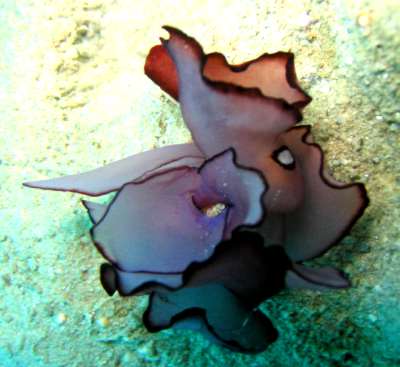
Hi Bill,
I'm not sure if what we found is in fact a nudibranch. Someone said it was a flatworm but we have not been able to find it on the Marine Flatworms of the World website.
We've seen it on several occasions too (crawling on the sandy bottom).
They are beautiful!
No the animal was not tangled up in any way - we found one crawling about
5 to 10 metres away from another one on two separate occasions. Both times off our House Reef (Tekek Village, Tioman, Malaysia) on a slightly sloping silt/sand bottom between 15 to 20 metres near our House wreck. They move along slowly on the sand in this shape and same colour (rose like).
Thanks & Regards,
Michelle Tay & Jeffree Shahrizal
www.eco-divers.net
mail@eco-divers.net
Tay, M. & Shahrizal, J., 2005 (Jun 4) Flatworm? from Malaysia. [Message in] Sea Slug Forum. Australian Museum, Sydney. Available from http://www.seaslugforum.net/find/13931Dear Michelle & Jeffree,
I'm afraid I can't make out if there is one or more animals in the photo. There seems to be too many 'flaps' for flatworms. They remind me a bit of juvenile batfishes which drift around in shallow water looking like dead leaves, but as you have seen them crawling on the bottom it cancels out that bright idea. Could they possibly be a pair of mating flatworms?
Perhaps if you have a photo of a this animal(s) crawling I might have a better idea of their shape.
Best wishes,
Bill Rudman
